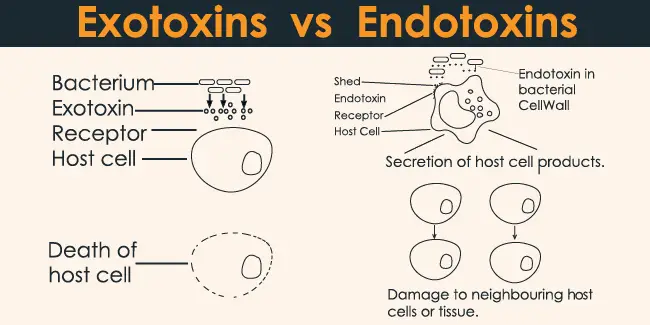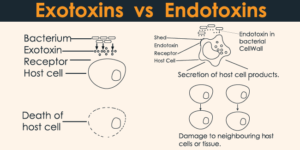
Endotoxins vs Exotoxins, Interesting Differences And Comparisons
A toxin is a substance produce by living cells or organisms. Toxins produced by various types of organisms such as bacteria, fungi, plants, and animals.
Mostly bacteria produce pigments enzymes and toxins. Enzymes and toxins play a vital role in pathogenicity.
Bacterial toxins, harmful molecules produce by bacteria and divide into two large groups, that of ENDOTOXINS and that of EXOTOXINS.

The main difference between endotoxins vs exotoxins is that Endotoxins bacterial toxic substances that are structural components of certain bacteria and release only during lysis of a bacterial cell. While Exotoxins are not structural components, but simply substances release externally by the bacterium.
I guess you want to learn more about it.
Let’s dig into more detail. Here’s more detail about it.
Endotoxins vs Exotoxins Differences
| Endotoxins | Exotoxins |
| 1. Cell wall components, release after bacterial lysis. | Most live bacteria secrete, a few releases after lysis. |
| 2. They are lipopolysaccharides. | They are proteins nature, therefore water-soluble |
| 3. All gram-negative bacteria. | Most gram-positive bacteria, few gram-negative bacteria. |
| 4. They are thermostable (very resistant to high T °) 160℃ destroy for 2-4 hours. | They are thermolabile (destroy by heat) 60℃ destroy in half an hour. |
| 5. No enzymatic activity, because they are not proteins. | Usually, they are proteins with enzymatic activity. |
| 6. Weak, the toxic effects of each bacteria are similar, causing fever, leukocytosis, microcirculation disorder, shock, etc. | The strong, selective toxic effect on tissue cells, causing special clinical manifestations. |
| 7. More resistant. | Denaturable, if treated with substances, adequate chemicals, such as acids. |
| 8. Less toxic. | Highly toxic and often fatal. |
| 9. Relatively little immunogenic, sometimes the immune response is not enough to neutralize the toxin. | Strong, stimulate the host to produce anti-toxin, detoxify into toxoid after treatment with formaldehyde solution. |
| 10. They do not stimulate the production of antibodies and are not detoxifiable (they are bad antigens ). | They stimulate our organism to produce specific antibodies (they are excellent antigens). |
Video related endotoxins vs exotoxins:
Definition of endotoxin:
The endotoxins are situated in the cell envelope or external layer of the microorganisms, these are alluded to as cell-related substances that are answerable for the auxiliary segments of microbes.
Endotoxins are likewise called as Lipopolysaccharides or LPS. The LPS are available on the external surface of the Gram-negative microbes and under some condition get poisonous to the host to which it is appended.
In the domain of bacteriology, the term ‘Lipopolysaccharides’ is held to the intricacy related to the external surface of the Gram-negative microorganisms like Escherichia coli, Pseudomonas, Shigella, Haemophilus flu, Vibrio cholerae, and Bordetella pertussis.
The LPS released at the bacterial cell lysis or cell passing. In this, the harmfulness is identified with the lipid segment (Lipid), some time immunogenicity is with polysaccharide parts.
In the creatures, the LPS bring out various provocative reactions and initiates supplement by the elective pathway. The Gram-negative microorganisms discharge a limited quantity of endotoxin while developing, which assumes a significant part in improving the characteristic invulnerability.
Definition of exotoxins:
Exotoxins are typically large discharged by microbes and act enzymatically or with the immediate activity of the host cell.
These are delivered by microbes into the encompassing. Exotoxins are proteins or polypeptides, and a large portion of them act at tissue site which is away from the first purpose of bacterial development or intrusion.
Typically, the exotoxins are emitted at the exponential period of the bacterial cell. The poison creation is explicit to specific types of microorganisms which are known to deliver illness like for instance Clostridium tetani are known to deliver lockjaw poisons; Cornybacterium diphtheria is known to deliver diphtheria poison.
These are the destructive strains of the bacterium which produce poisons, though nonvirulent strains don’t. Exotoxins are viewed as the most harmful and deadly substance, and they are poisonous even in nanogram-per-kilogram of focuses.
Endotoxins vs exotoxins key contrasts.
- Endotoxins are the aspect of the cells, as they are related with the external layer of the Gram-negative microscopic organisms, and is delivered at the cell lysis, while exotoxins are discharged inside the cell and are dynamic in Gram-positive and Gram-negative microorganisms. Exotoxins are delivered from the cell.
- Endotoxins are the lipopolysaccharide-protein buildings (LPS), liable for making a vital aspect of the cell mass of Gram-Negative Bacteria. Exotoxins are the proteins which are discharged by a couple of types of microbes. In spite of the fact that endotoxins are viewed as a greater number of poisons than exotoxins.
- Endotoxins are steady at 250 ° C and don’t get denatured, while exotoxins are at risk are 60-80 ° C and gets denatured on bubbling.
- The atomic load of endotoxins might be within the range of 50-1000KDa and are related with the Lipopolysaccharide complex, then again, the exotoxins have the sub-atomic load of 10KDa and is identified with the protein complex.
- Reactions related to immune gets frail when endotoxins trigger the phone and have high enzymatic movement however helpless antigenicity, while during exotoxins responses the resistant responses are solid, however there is no enzymatic action and high antigenicity.
- Instances of the microorganisms by which the LPS or endotoxins are set off are Salmonella typhi, E.coli, Vibrio cholera, Shigella, while Bacillus cereus, Bacillus anthracis, Staphylococcus aureus, Streptococcus pyrogens are models for setting off exotoxins.
- Sepsis, meningococcemia is the ailment brought by the endotoxins, while Diptheria, botulism, lock-jaw are brought by exotoxins.
What is Endotoxins and its examples?
Endotoxin is a toxic substance in a bacterial cell that releases when the bacterial cell decays. They are lipopolysaccharide which presents in the cell wall of Gram-negative bacteria. The outer membrane is unique for gram-negative bacteria. Therefore, they always associate with gram-negative bacteria.
They are usually not soluble either. However, they are heat-resistant and cannot be destroyed by boiling.
Lipopolysaccharide is toxic to the host. The lipopolysaccharide molecule composes of three parts: cell-specific polysaccharide, non-specific core polysaccharide, and lipid A. Lipid A is the main toxic component of endotoxin.
The presence of endotoxins in the blood is called endotoxinemia. With a strong immune response, endotoxinemia can lead to septic shock.
Examples
A prime example is a lipopolysaccharide or lipooligosaccharide. Moreover, the insecticidal delta-toxin of the gram-positive Bacillus thuringiensis is another example. This toxin is a protein synthesized by the bacillus during sporulation and forms crystals in the bacterial spore. Delta-toxin is harmless to humans.
What is Exotoxins and its examples?
Exotoxins release into the external medium by viable cells. Most of the exotoxins synthesize in the cell during the metabolism of toxin-producing bacteria and secrete out of the bacteria. Most exotoxins are not heat resistant and can be destroyed by heating them at 60°C for half an hour.
They are usually enzymes that have enzymatic activity. They produce by Gram-positive bacteria.
It is a type of protein that can stimulate the host immune system to produce a good immune response and form a specific immunoglobulin that can neutralize the toxicity of exotoxin. This globulin is called antitoxin.
They have a toxic effect on the human body, disrupt processes in the cell.
Usually, they are unstable, quickly lose their activity under the influence of heat, light, and chemicals, but retain their immunogenic properties.
Exotoxins divide into:
- Neurotropic
- Enterotoxins
- Pantrope
Examples
Eaxmples are as follows:
- Streptococcus pyogenes
- Bacillus anthrcis
- Staphylococcus aureus
- Bacillus cereus
Similarities between Endotoxins vs Exotoxins
Following are a few similarities between endotoxins vs exotoxins
- Both produced by pathogenic bacteria.
- Both are toxic substances
Conclusion (Endotoxins vs Exotoxins)
Bacterial poisons are the most remarkable and successful human toxic substances and exceptionally dynamic at high weakenings. In this substance, we reached think about endotoxins and exotoxins and how they contrast and influence the creatures and their safe framework by their concoction nature.
You may also enjoy reading: